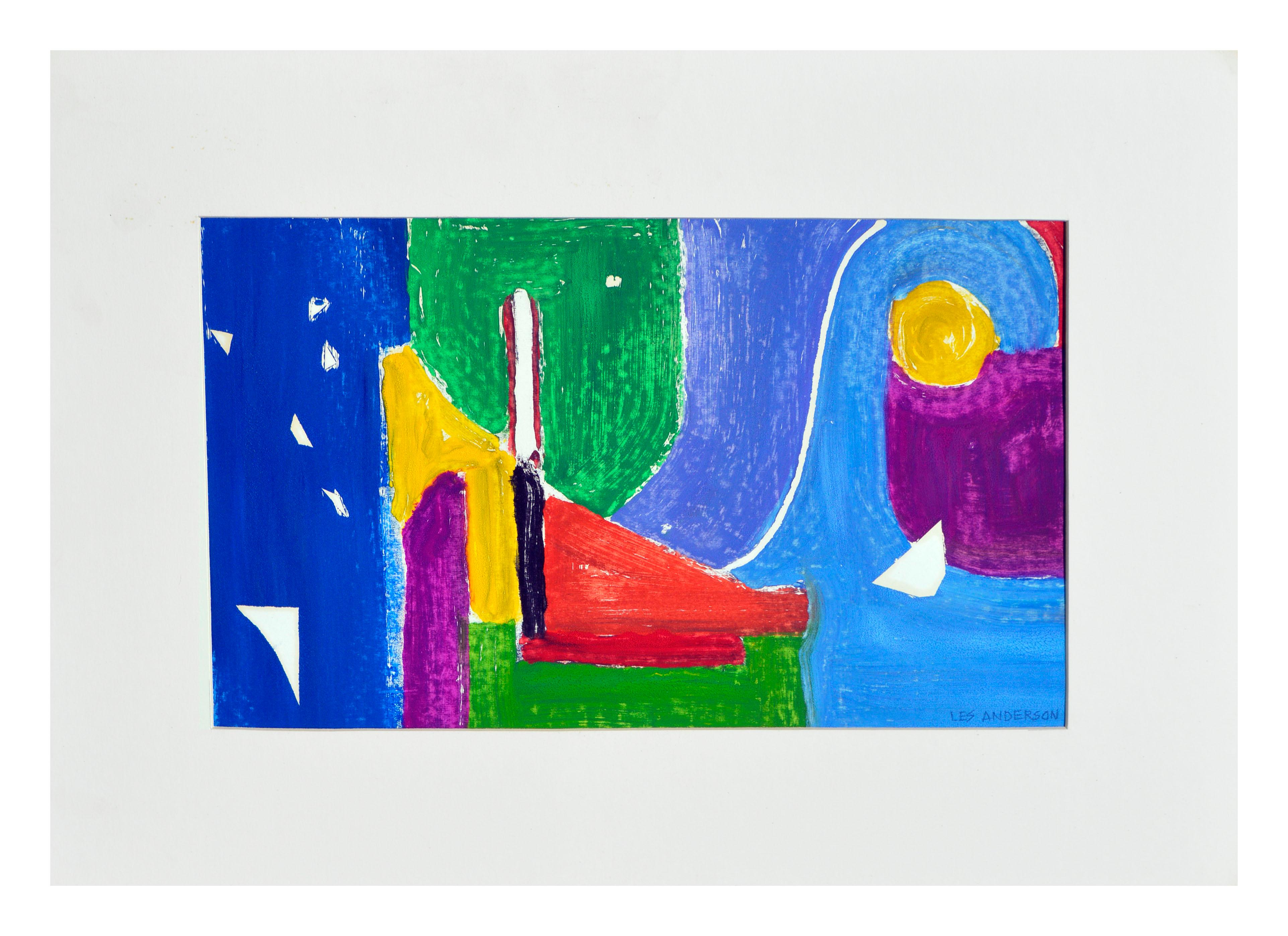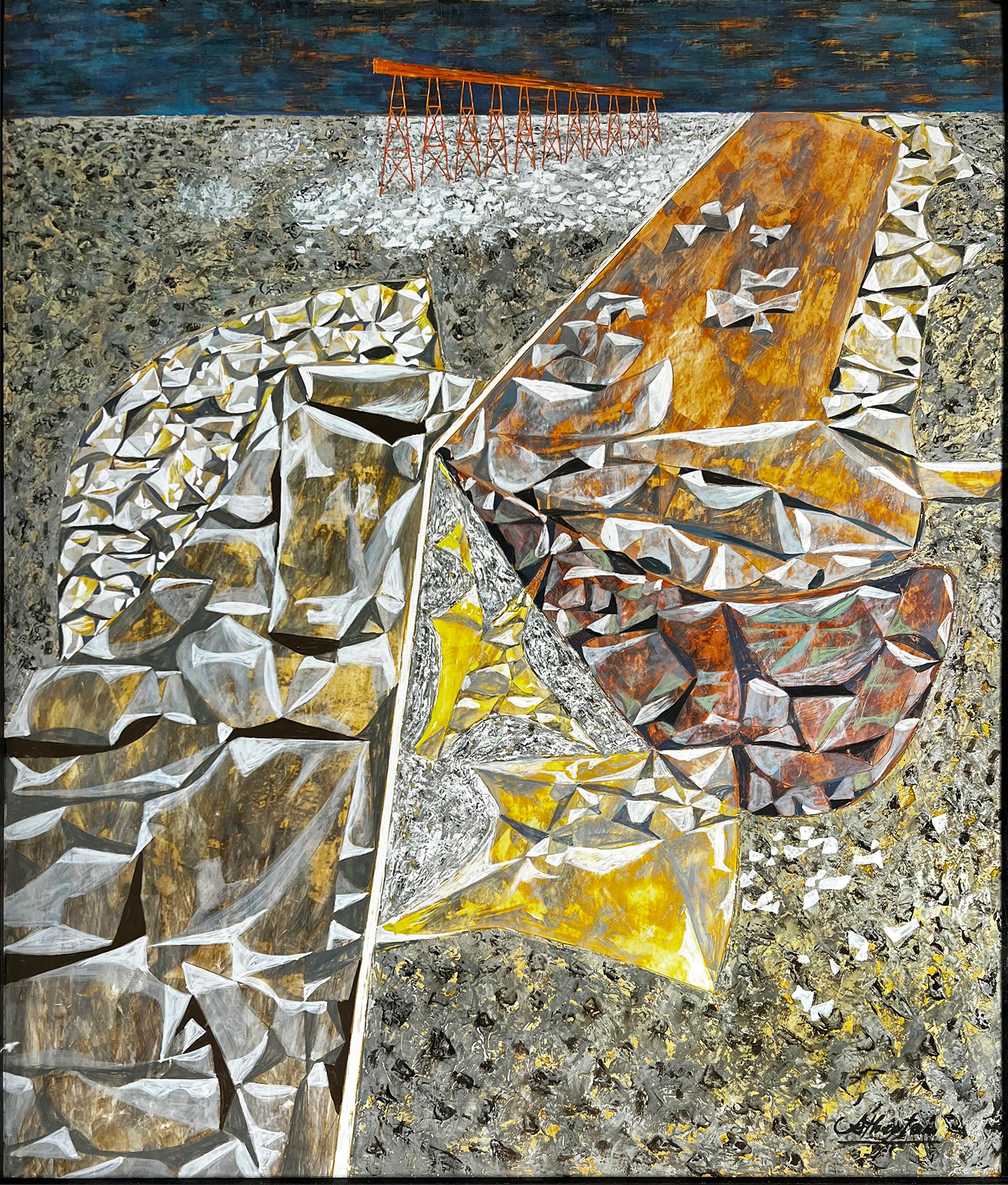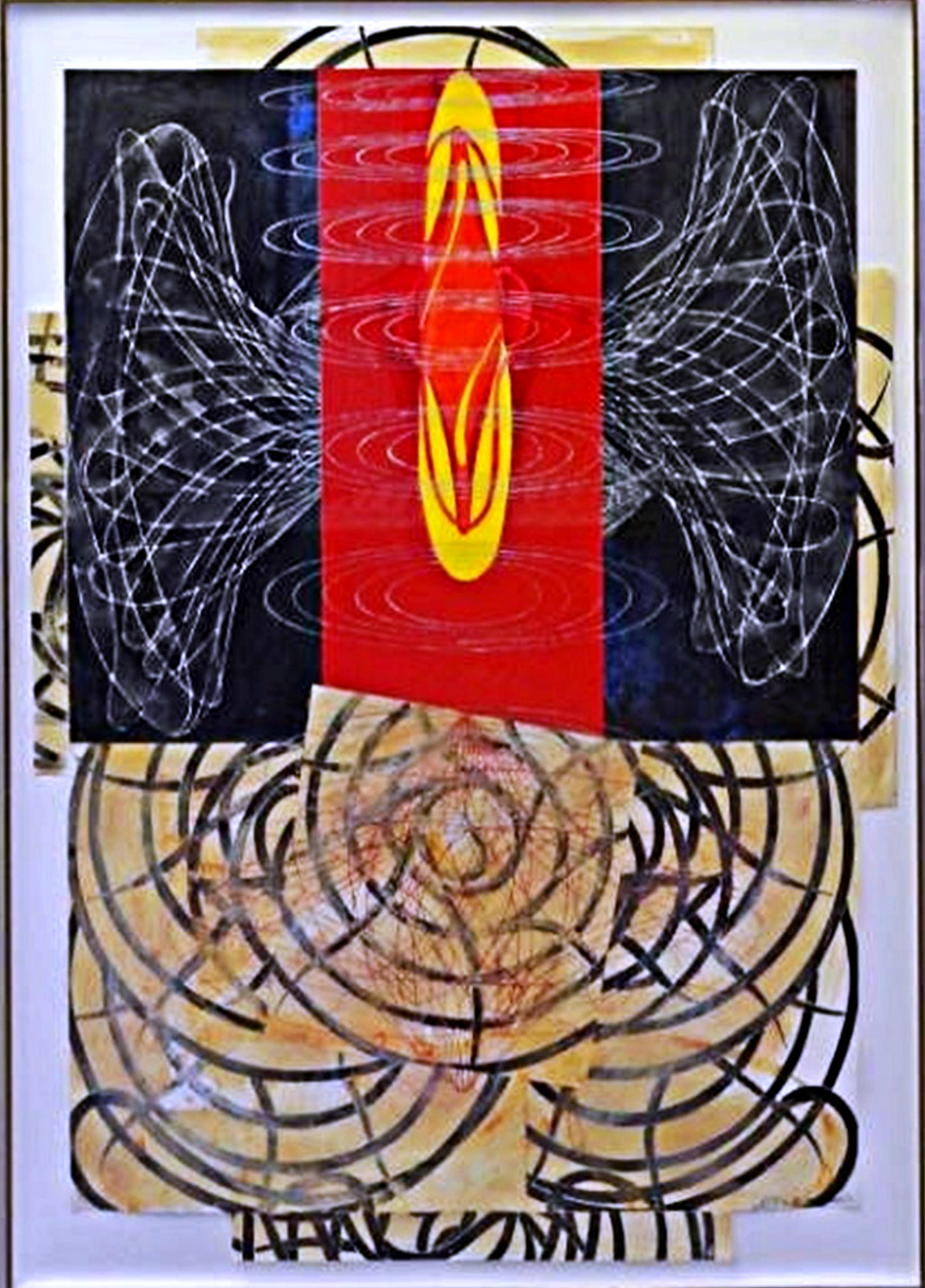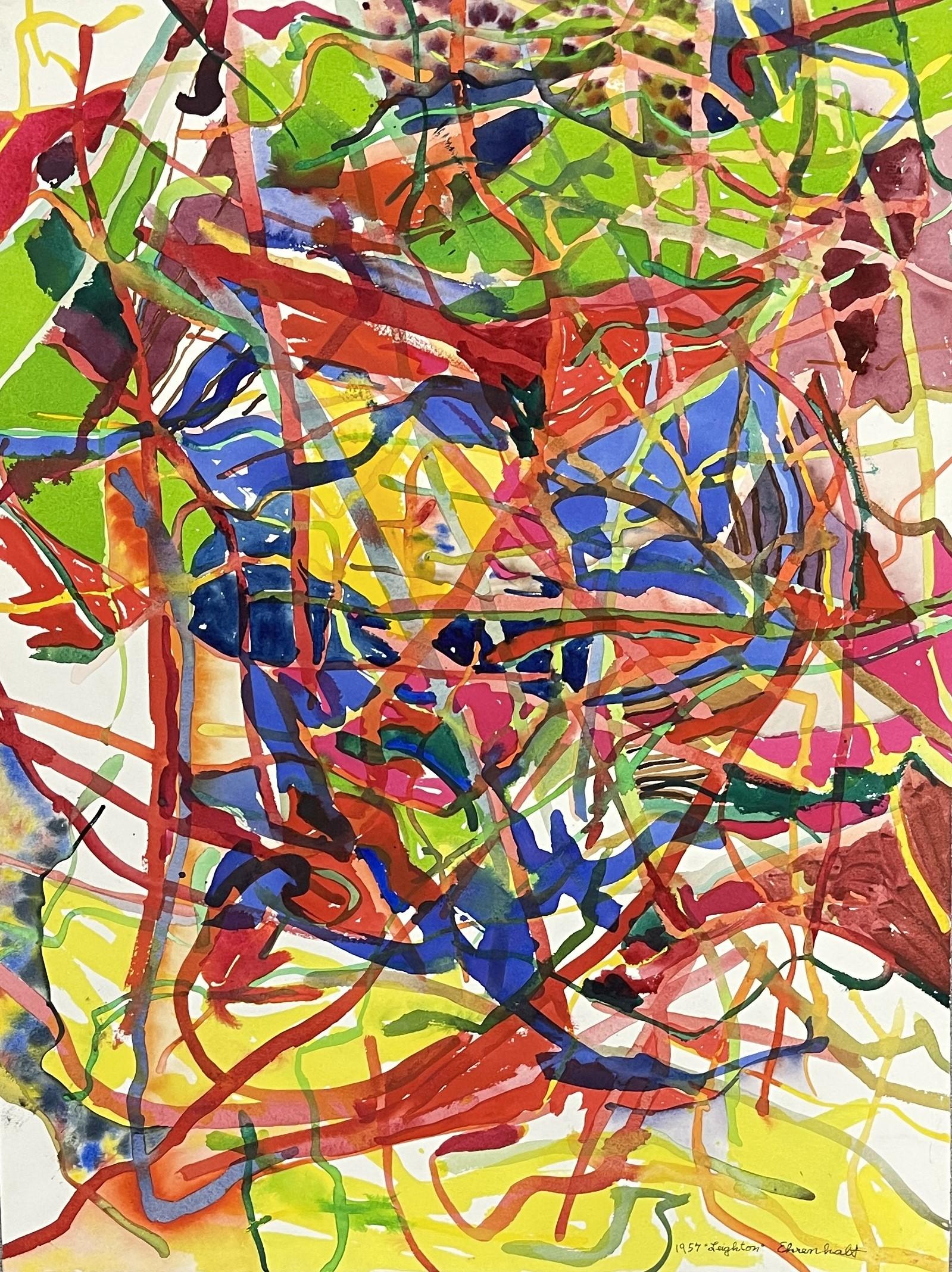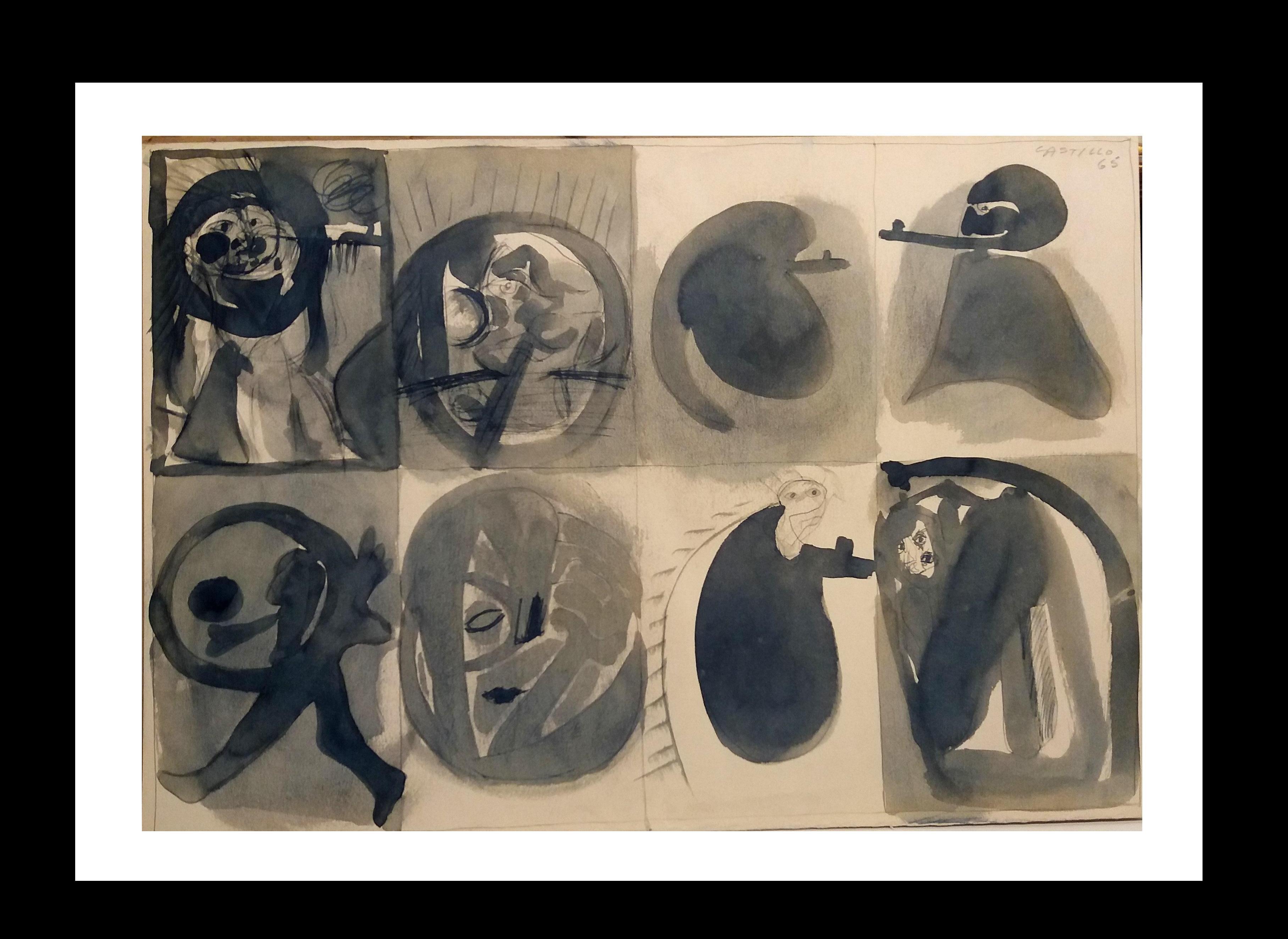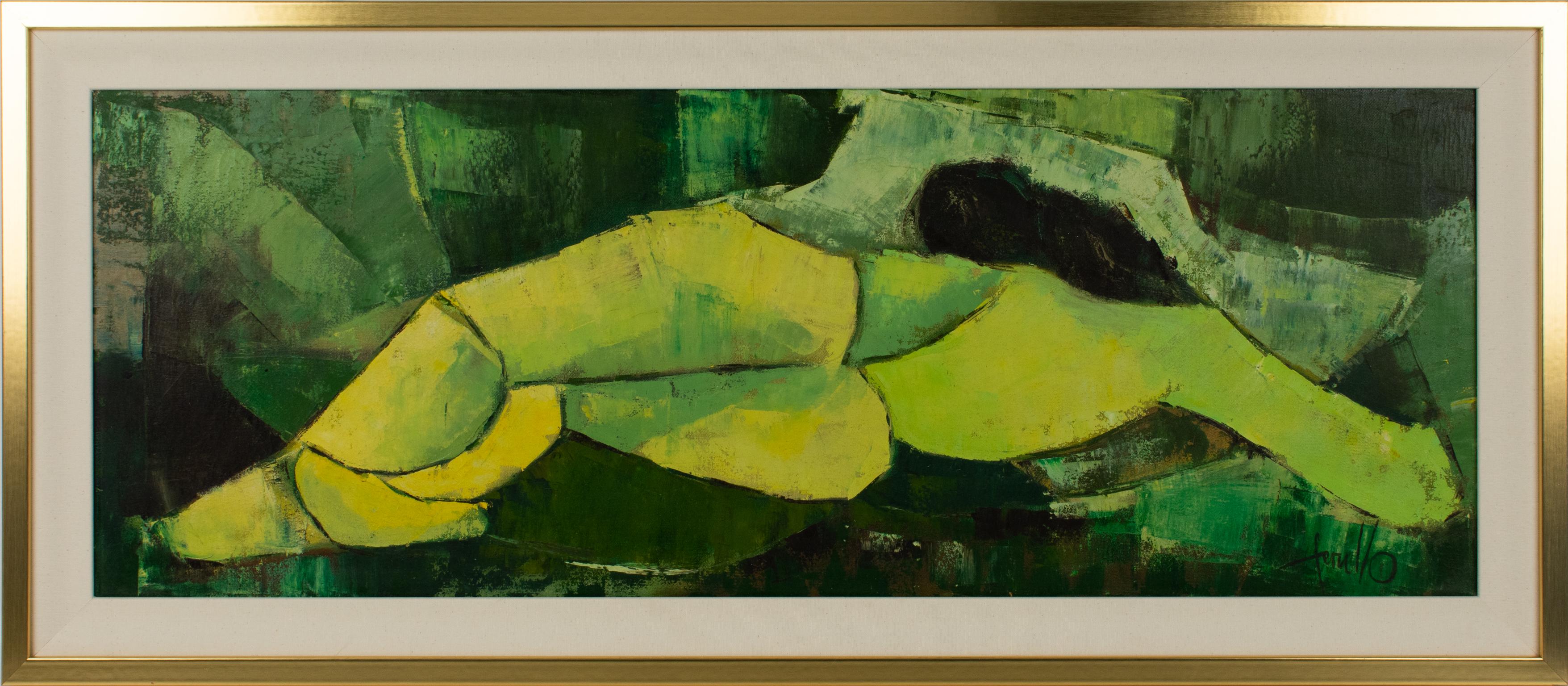Items Similar to French Expressionist Abstract Original Beige Colours
Want more images or videos?
Request additional images or videos from the seller
1 of 7
Jacques Coulais (1955-2011)French Expressionist Abstract Original Beige ColoursMid 20th Century
Mid 20th Century
About the Item
Abstract Expressionist Composition
by Jacques COULAIS (1955-2011) watercolour painting on thick card
unframed: 30.5 x 23 inches
condition: excellent
provenance: all the paintings we have for sale by this artist have come from the artists studio and are all featured in the artists Catalogue Raisonne.
Jacques, Paul, Firmin Coulais is a French painter born on March 22 , 1955 in Fenioux ( Deux-Sèvres ) and died at the age of 56, the June 25 , 2011 in Niort (Deux-Sèvres). Born into a farming family, he was the seventh of eight children.
Suddenly becoming a quadriplegic at the age of six following poliomyelitis, he overcame this handicap by building with determination an independent life centered on artistic practice and an intense social life. For more than thirty years his house and his workshop have been the center of attraction for many artists, art lovers or simply friends of Niort and all of France.
Coulais began to paint with his mouth, as an autodidact. In 1978, he made the acquaintance of a plastic art teacher who advised him and engaged him on the path of watercolour. The freedom granted to him by this technique as well as the flexibility of its application fascinate him. This meeting and the friendship shared with his teacher, lead him and very quickly direct his work from figurative to abstraction in a way that he explores and that he will then find in the works of Kandinsky and Paul Klee.
Admitted to the School of Fine Arts in Angoulême, he studied there from 1981 to 1984 and obtained the National Superior Diploma in Plastic Expression at the age of 31. A few years later, Jacques Coulais exhibited at the Museum of Niort and since then, his career has been punctuated by his participation in numerous exhibitions organized very regularly in various French cities as well as abroad.
In the 1990s, the AAPBP, Association of Mouth and Foot Painting Artists, opened its doors to him. It gives artists the opportunity to support themselves and devote themselves to their art, free from worries and concerns.
Jacques Coulais becomes a scholarship holder of the Association. Two years later, he obtained the status of associate member. He has been a full member since 1998. This remarkable association organizes numerous artistic events every year. The painting of Jacques Coulais is most often abstract painting nourished by his training, his extensive and precise culture and the dreams, or more frequently nightmares, which populated his nights and whose memory he has preserved through four notebooks that he wrote himself. His painting is done either with his mouth or directly on the ground with the wheels of his chair.
He had a very thick paper or a canvas, usually square, installed at his table, the brushes, the colors. Anyone present could prepare their colours. He gave extremely precise instructions in everything and got exactly the shade he was looking for. They handed him the brush he was holding with his mouth. For large formats, the brush was attached to a rod that could reach a meter in length.
Mastering a very elaborate watercolor technique, he produces his works with his mouth with relentless meticulousness: a “pensive” painting made of “repetitive and patient gestures” which “are a matter of working on oneself ” . This painting refers either to the mandala - a multitude of stains and colors cover the surface and give it its rhythm and its light - or to the calligraphic painting, a singular writing, devoid of meaning whose main driving force is the unconscious, an abstract writing that only expresses its own aesthetics. “It is only a question of one thing, namely, the fundamental impossibility of describing, of writing a representation of the world. Perhaps it is only an attempt at poetic gesture!… For someone whose body has abandoned, gesture is vital.
Bibliography
Catalog of the exhibition at the Musée du Donjon , Niort, 1991.
In absentia , text by Ami Barak, works by Jacques Coulais, ACAPA Éditeur, 1992.
Of the sign, of the interpretation, of the incompleteness : interview with Paul Ardenne and Jacques Coulais, Revue La Licorne no 23 , 1992.
Art, the Contemporary Age , Paul Ardenne, Editions du Regard, 1997.
A small grammar of signs , Jacques Coulais, Cultural Action of the University of Poitiers, 2002.
Portfolio of 18 watercolours, text by Dominique Moncond'huy, 2003.
Paintings Please, Pay Attention, Please , Barbara Polla & Paul Ardenne, Editions Le Bord de l'Eau – La Muette collection, 2010.
Jacques Coulais Pictor Maximus, Body & Canvas . texts by Barbara Polla and Paul Ardenne, interview with Ali kazma, Éditions TAKE FIVE - Trait d'Union collection, 2011.
Continuum , texts by Jacques Coulais and Régis Busschaërt, Éditions Le Courtil des Roses, 2011.
- Creator:Jacques Coulais (1955-2011) (1955 - 2011, French)
- Creation Year:Mid 20th Century
- Dimensions:Height: 30.5 in (77.47 cm)Width: 23 in (58.42 cm)Depth: 1 in (2.54 cm)
- Medium:
- Movement & Style:
- Period:
- Condition:
- Gallery Location:Cirencester, GB
- Reference Number:1stDibs: LU509314068192

About the Seller
5.0
Platinum Seller
These expertly vetted sellers are 1stDibs' most experienced sellers and are rated highest by our customers.
Established in 1989
1stDibs seller since 2016
3,571 sales on 1stDibs
Typical response time: 2 hours
- ShippingRetrieving quote...Ships From: Cirencester, United Kingdom
- Return PolicyA return for this item may be initiated within 3 days of delivery.
More From This SellerView All
- French Expressionist Abstract OriginalLocated in Cirencester, GloucestershireAbstract Expressionist Composition by Jacques COULAIS (1955-2011) watercolour painting on thick card unframed: 26 x 20 inches condition: excellent provenance: all the paintings we h...Category
20th Century Abstract Expressionist Abstract Paintings
MaterialsWatercolor
- French Expressionist Abstract Original Brown and Yellow PaintingLocated in Cirencester, GloucestershireAbstract Expressionist Composition by Jacques COULAIS (1955-2011) watercolour painting on thick card unframed: 26 x 20 inches condition: excellent provenance: all the paintings we h...Category
20th Century Abstract Expressionist Abstract Paintings
MaterialsWatercolor
- French Expressionist Abstract Original PaintingLocated in Cirencester, GloucestershireAbstract Expressionist Composition by Jacques COULAIS (1955-2011) watercolour painting on thick card unframed: 26 x 20 inches condition: excellent provenance: all the paintings we h...Category
20th Century Abstract Expressionist Abstract Paintings
MaterialsWatercolor
- French Expressionist Abstract Original Yellow Blue ColoursLocated in Cirencester, GloucestershireAbstract Expressionist Composition by Jacques COULAIS (1955-2011) watercolour painting on thick card unframed: 25.5 x 19.5 inches condition: excellent provenance: all the paintings ...Category
20th Century Abstract Expressionist Abstract Paintings
MaterialsWatercolor
- Abstract Expressionist British Original Watercolor Painting Shapes PatternsBy Robert SomertonLocated in Cirencester, GloucestershireAbstract Composition (c.2022) by Robert Somerton, British, born 1972. ink/ watercolor on art paper, unframed size: 9.5 x 12.5 inches condition: excellentCategory
2010s Abstract Expressionist Abstract Paintings
MaterialsInk, Watercolor
- Abstract Expressionist British Original Watercolor Painting LandscapeBy Robert SomertonLocated in Cirencester, GloucestershireAbstract Composition (c.2022) by Robert Somerton, British, born 1972. ink/ watercolor on art paper, unframed size: 9.5 x 12.5 inches condition: excellentCategory
2010s Abstract Expressionist Abstract Paintings
MaterialsInk, Watercolor
You May Also Like
- Marina Geometric Abstract WatercolorBy Les AndersonLocated in Soquel, CAVibrant marina abstract with bold colors and geometric forms by Les (Leslie Luverne) Anderson (American, 1928-2009). From the estate of Les Anderson in Monterey, California. Signed "...Category
1980s Abstract Expressionist Landscape Paintings
MaterialsPaper, Watercolor
- Thought Provoking Rock Quarry - Mid Century AbstractLocated in Miami, FLThis meticulously planned, designed, and executed work depicts an ultra-wide angle view of a rock quarry/mine. The viewer looks down at close-up-stylized rock formations and then out at a horizon line with rust-colored mine trestles. Atherton hints at perspective with a broken white line that is wider in the foreground and tapers to a hairline as it recedes to the background. The work was done in 1951 at the height of America's most important art movement: Abstract Expressionism. John Atherton absorbs its influences but retains elements of representation. Atherton was an in-demand commercial artist who worked for most blue-chip clients. It is possible that this was an editorial assignment for Fortune Magazine. At the same time, Atherton was also a fine artist and the work could be an expression of pure creative pursuits. The work looks better in person and one can look at it for hours and not get bored. Look carefully and you may discover a deeper meaning in this painting of precisely arranged rocks. Signed lower right. Brooklyn Museum of Art, New York, sold to benefit the acquisitions program ____________________ From Wikipedia, the free encyclopedia John Carlton Atherton (January 7, 1900 - September 16, 1952) was an American painter and magazine illustrator, writer and designer. His works form part of numerous collections, including the Museum of Modern Art,[1] Whitney Museum of American Art and the Smithsonian American Art Museum.[2][3][4] Early Years He was the son of James Chester Atherton (1868-1928) and Carrie B. Martin (1871-1909). He was born in Brainerd, Minnesota.[5] His father was Canadian born. His parents relocated from Minnesota to Washington State, with his maternal grandparents whilst he was still an infant. He attended high school in Spokane, Washington. Career During his early years he never displayed an aptitude for art; rather, his first love being nature and the activities he relished there, mainly fishing and hunting. He enlisted in 1917, serving briefly in the U.S. Navy for a year during World War I. At the end of the war, determined to get an education he worked various part-time jobs, as a sign painter and playing a banjo in a dance band to pay his enrolment fee at the College of the Pacific and The California School of Fine Arts (now the San Francisco Art Institute). Once there, he also worked in the surrounding studios developing his oil painting techniques. A first prize award of $500 at the annual exhibition of the Bohemian Club in 1929, financed his one way trip to New York City, which helped to launch his career as an artist.[6] Atherton had aspired to be a fine artist, however his first paid jobs were for commercial art firms designing advertisements for corporations such as General Motors, Shell Oil, Container Corporation of America, and Dole. However, by 1936, encouraged primarily by friends, such as Alexander Brook, an acclaimed New York realist painter, he returned to the fine arts. Atherton continued to accept numerous commissions for magazine illustrations; such as Fortune magazine, and over the years he would paint more than forty covers for The Saturday Evening Post starting with his December 1942 design, “Patient Dog.” This picture is reminiscent of his friend Norman Rockwell ‘Americana style’ and captures a poignant moment of nostalgia, where a loyal dog looks toward a wall of hunting equipment and a framed picture of his owner in military uniform. Selected One person Exhibitions Atherton accomplished his first one-man show in Manhattan in 1936. His Painting, “The Black Horse” won the $3000 fourth prize from among a pool of 14,000 entries. This painting forms part of the Metropolitan Museum of Art collection in New York.[7] Atherton achieved recognition in New York City and elsewhere during the 1930s. Having exhibited at the Julien Levy Gallery in New York,[8] his paintings began to be collected by museums; including the Museum of Modern Art[9] and the Metropolitan Museum of Art. His reputation increased with his art deco stone lithograph poster for the 1939 New York World's Fair. In 1941, his design won first place in the Museum of Modern Arts “National Defense Poster Competition”. Selected Public Collections Fleming Museum of Art, Burlington, Vermont Albright-Knox Art Gallery,[10] Buffalo, NY Art Institute of Chicago,[11] Chicago Wadsworth Atheneum,[12] Hartford, CT Brooklyn Museum of Art, New York Metropolitan Museum of Art, New York The Museum of Modern Art,[13] New York Whitney Museum of American Art,[14] New York Pennsylvania Academy of the Fine Arts,[15] Philadelphia De Young Museum,[16] San Francisco Smithsonian American Art Museum,[17] Washington DC Butler Institute of American Art[18] Youngstown, OH The Famous Artists School Founded in 1948 in Westport, Connecticut, U.S.A. The idea was conceived by members of the New York Society of Illustrators (SOI), but due to the Society's legal status, could not be operated by it. SOI member Albert Dorne led the initiative to set up a separate entity, and recruited the support of Norman Rockwell, who was also an SOI member. For the founding faculty, Dorne recruited Atherton, as well as accomplished artists such as Austin Briggs, Stevan Dohanos, Robert Fawcett, Peter Helck, Fred Ludekens, Al Parker, Norman Rockwell, Ben Stahl, Harold von Schmidt and Jon Whitcomb.[19] He collaborated with Jon Whitcomb with the book “How I Make a Picture: Lesson 1-9, Parts 1”.[20][21] Society of Illustrators Atherton as an active member from his arrival in New York. The society have owned many of his works. Ex-collection includes: Rocking Horse (ca. 1949) [22] Atherton, as his peers had many of his works framed by Henry Heydenryk Jr.[23] Personal On November 2, 1926, he married Polly “Maxine” Breese (1903-1997).[24][25] They had one daughter, Mary Atherton, born in 1932. Atherton's often chose industrial landscapes, however found himself spending considerable time in Westport, Connecticut, with an active artistic community, and it became home for him, and his family. He then moved to Arlington, Vermont.[26] Norman Rockwell enlisted Atherton in what was to be the only collaborative painting in his career.[27] He was part of a group of artists including a Norman Rockwell, Mead Schaeffer and George Hughes who established residences in Arlington.[28] Atherton and Mead Schaeffer were avid fly fishermen and they carefully chose the location for the group,[29] conveniently located near the legendary Battenkill River. In his free time, Atherton continued to enjoy fly-fishing.[30] He brought his artistic talent into the field of fishing,[31] when he wrote and illustrated the fishing classic, “The Fly and The Fish”.[32] He died in New Brunswick, Canada in 1952,[33] at the age of 52 in a drowning accident while fly-fishing.[34] Legacy The Western Connecticut State University holds an extensive archive on this artist.[35] His wife, Maxine also published a memoir “The Fly Fisher and the River” [36] She married Watson Wyckoff in 1960. Ancestry He is a direct descendant of James Atherton,[37][38] one of the First Settlers of New England; who arrived in Dorchester, Massachusetts in the 1630s. His direct ancestor, Benjamin Atherton was from Colonial Massachusetts...Category
1950s Abstract Expressionist Abstract Paintings
MaterialsMixed Media, Gouache, Board
- In Real Time, unique signed Abstract Expressionist painting compared to MatisseBy Steven SormanLocated in New York, NYSteven Sorman In Real Time, 2003 Acrylic, gouache, gel medium, oil and beeswax collage painting on paper 48 × 34 inches Signed and dated 2003; The frame also bears the original label...Category
Early 2000s Abstract Expressionist Abstract Paintings
MaterialsMixed Media, Oil, Acrylic, Gouache, Gel Pen, Graphite
- LeightonBy Amaranth EhrenhaltLocated in Lawrence, NYAmaranth Ehrenhalt was a multifaceted artist best known for her paintings. She was part of the second generation of Abstract Expressionists, working first in New York in the early 19...Category
1950s Abstract Expressionist Abstract Paintings
MaterialsWatercolor
- Castillo Far West original expressionist abstract paper paintingBy Jorge CastilloLocated in CORAL GABLES - MIAMI, FLFar west original expressionist abstract paper painting CASTILLO, Jorge (Pontevedra, 1933). Since childhood, Jorge Castillo is passionate about drawing, and takes only ten years, wi...Category
1960s Abstract Expressionist Abstract Paintings
MaterialsWatercolor
- Mid Century Abstract Nude Oil on Canvas Painting by Edith FerulloBy Edith E. FerulloLocated in Atlanta, GAOriginal Mid-Century oil on canvas composition by American Artist Edith E. Ferullo (1928 - 2008). The painting features a thick textured abstract nude subject. The brutalist artwork ...Category
1960s Abstract Expressionist Abstract Paintings
MaterialsCanvas, Acrylic, Gouache
Recently Viewed
View AllMore Ways To Browse
Small Vintage Abstract Art
Mid Century French Abstract
Kandinsky Original
Farming Art
Barbara Grant
Paul Klee Exhibition
Expressionist Klee
Used Event Chairs
Art De France Shade
Paul Klee Original
Used Childrens School Chairs
Vintage Amis
Musee De Sevres
Mid Century Abstract Lovers
Vintage Calligraphy Brush
Vintage Calligraphy Brushes
Card Catalogue
Mandala Vintage
